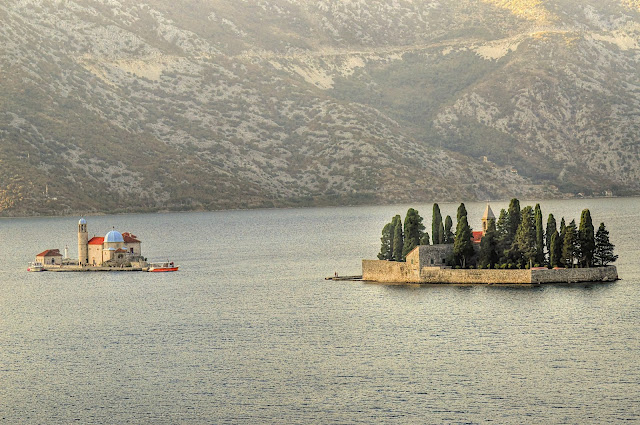September 5, 2012 we doked in Kotor one of my favorite place in Europe is Kotor, the place was so bountiful in historical and magical hidden treasure. I brought my camera NIKON D 5000 together my some friends on ship we explore the city by walk 1 and half hour until we reached the moment the church was built in the middle of lake canal. I was astonished God has set every city with unique artistic classical and historical place.
The Town of Kotor is located in the Boka Kotorska Bay which was included in the list of world's most beautiful bays in July 2000. The rest of them are located mostly in Scandinavia.
The area of Kotor is characterised by hot, dry summers, and mild, humid winters. The average annual temperature is 15.2°C. The warmest month is July with an average air temperature of 25°C, and the coldest month is January with average air temperature of 7.4°C. On average, autumn is 2.9°C warmer than spring.
On average, Kotor gets 2,152 mm of precipitation a year. Most precipitation comes in the autumn (248 mm) and winter months (243 mm), whilst summer months are the driest, with 68 mm of precipitation. The most frequent winds are south-easterly and northerly (the "Bura"). In the period from mid-May to mid-October, the sea temperature reaches values above 18°C, which enables a bathing season with a duration of as long as 144 days.
Kotor is situated at the deepest end of the Boka Kotorska Bay. Here, history follows in continuity from ancient times.
In surrounding caves, traces have been found of human existence from Neolithic times in the form of various tools, accessories and drawings on the walls of the caves. One of them is Lipci near Risan.
Kotor is situated in the south-eastern part of the Boka Kotorska Bay, at the foot of Mount Lovcen. The municipality of Kotor covers an area of 355 km2. Kotor is a cultural, educational, scientific, health, .commercial and sports centre, which is characterised by a Mediterranean climate, with mild and rainy winters and warm summers.
One cannot with any certainty say the exact time of its establishment. Kotor is mentioned for the first time as Acruvium in the first century A.D., although it has not been precisely determined whether Acruvium was been the name of the present-day Kotor, or rather one of the surrounding settlements.
The Town of Kotor changed many rulers and administrations during its vibrant history. It was ruled by the lllyrians, Romans, Byzanthians... The first Slavic tribes settled this area in the 7th century A.D. while the first Slavic state was Doclea, followed by Zeta. From the end of the 12th century, Kotor fell under the rule of the Nemanjic dynasty, and in 1420 came the Venetian Republic, which remained until its fall in 1797, when Europe was shaken by the Napoleonic Wars. Following the tumultuous period from 1797 to 1814, this area was alternately ruled by Russians, French, Austro-Hungarians and Montenegrins. At the Vienna Congress of 1814, Kotor came under the authority of the Austro-Hungarian Monarchy. In 1918, this area became a part of the newly-established state of the South Slavs and has shared the destiny of its peoples until the present-day.
After World War II, Kotor tried to continue its tradition of maritime affairs, trade and, of course, tourism. However, on 15th April 1979, there was a catastrophic earthquake which disrupted plans for the further progress of Kotor. More than 600 monuments of culture were damaged, and about 110,000 objects of movable heritage were endangered, which meant more than a third of the monument heritage of Montenegro. Places like Kotor with preserved traces of past epochs are rare. Due to the unique mixture of various cultural influences, in 1979 Kotor was added to the UNESCO list of World Cultural Heritage sites. The most developed industrial branches at that time were trade and maritime affairs. In that way, Kotor has for centuries been one of the more significant maritime and trade centres, and in recent years even a tourist one, in this part of the Adriatic Sea.
enjoy and cheer!




























No comments:
Post a Comment